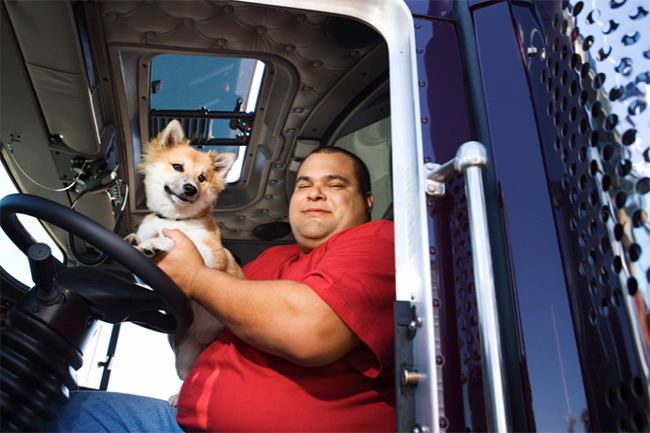 February 02, 2024 - BY EagleLogistics LLC
February 02, 2024 - BY EagleLogistics LLC
Having a canine companion can make the long hours on the road much less lonely. Whether you’re thinking of introducing a furry friend into your life, or if you’ve already got one back at home and want to start bringing them along for the ride, we’ve got lots of tips for driving cross country with a dog.
Know the Rules
First, you’ll want to find out if your company allows dogs. If they do, make sure you’re aware of any breed or weight restrictions for your potential pooch passenger.
Next, you’ll want to make sure your dog is up to date on their vaccinations— especially rabies— and that you have the paperwork to prove it. Speaking of paperwork, some states require a Certificate of Veterinary Inspection (CVI) or a Health Certificate signed by a licensed vet in your home state. It’s also a good idea to keep your dog’s microchip documentation and ownership papers on hand as well, if applicable.
As for federal rules, the FMCSA doesn’t seem to have any explicit regulations regarding driving cross country with a dog, as long as you can maintain a safe driving environment while doing so.
Prepare Your Dog
Depending on how old your dog is, how long you’ve had them, and how much prior training they’ve had, you may need to spend some time working with them to get them acclimated to life on the road. You’ll want to make sure they’re used to using a leash and collar, entering and exiting the vehicle, riding in the vehicle for extended periods of time, and that they’re potty trained. If you plan on keeping them in a crate or carrier, you should also get them comfortable using those before adding the element of riding in a truck.
We advise keeping a collar on your dog at all times with accurate, up-to-date contact information— just in case. You might also consider getting your pet microchipped, just for extra peace of mind. If you commit to thorough training, though, your dog will understand when it’s okay to exit the vehicle, and to always stay by your side. Proper training will also prevent damage to your truck from bathroom accidents, chewing, etc. and, most importantly, it will keep you and your pup safe during your travels.
Prepare Your Truck
Cab space can be limited, but it’s important to give your dog a space where they can sleep, relax, and play comfortably. We mentioned crates and carriers earlier, as these are both great ways to give your dog a dedicated space that’s all their own. Make sure their space has soft bedding and any other comfort items they might require to feel more at home. And don’t forget some toys! If your pooch has a chew toy or two to keep them occupied, they’re less likely to get restless and chew on something you don’t want them to— like the interior of your vehicle.
It’s also important to secure any loose items strewn about the cab. If things get bumpy, you don’t want your dog getting hit by anything rolling around or falling over. Plus, this will also prevent your pup from getting into anything they’re not supposed to.
If the door to your truck is high off the ground, we also suggest you invest in a collapsible ramp or pet stairs to assist your dog when entering and exiting the vehicle. Jumping in and out from up high can be hard on your dog’s body, and could even lead to injury.
Other helpful items to keep on hand are extra food and water, cleaning supplies in case of accidents, dog waste bags, and any medications your dog will need on a regular basis.
Additional Tips
Familiarize yourself in advance with vet offices, animal hospitals, and pet supply stores located along the route you’re taking. If you often take the same route, you’ll be able to locate these establishments and already know where they are for future reference. (If you need help, there’s a handy vet locator website you can use.) It’s important to take your dog to the vet regularly so they can stay healthy and happy, and so you can stay compliant with company and state regulations regarding pet passengers.
Another practice you’ll want to get in the habit of: stopping regularly to give your dog some fresh air, exercise, and a chance to go to the bathroom. Stretching their legs will also help them blow off steam and, again, stay out of trouble once they’re back in the truck with you. Of course these breaks will also benefit you as the driver.
Wondering what the rules are for bringing along a two-legged passenger? Check out our guide to rider policies for truck drivers!
